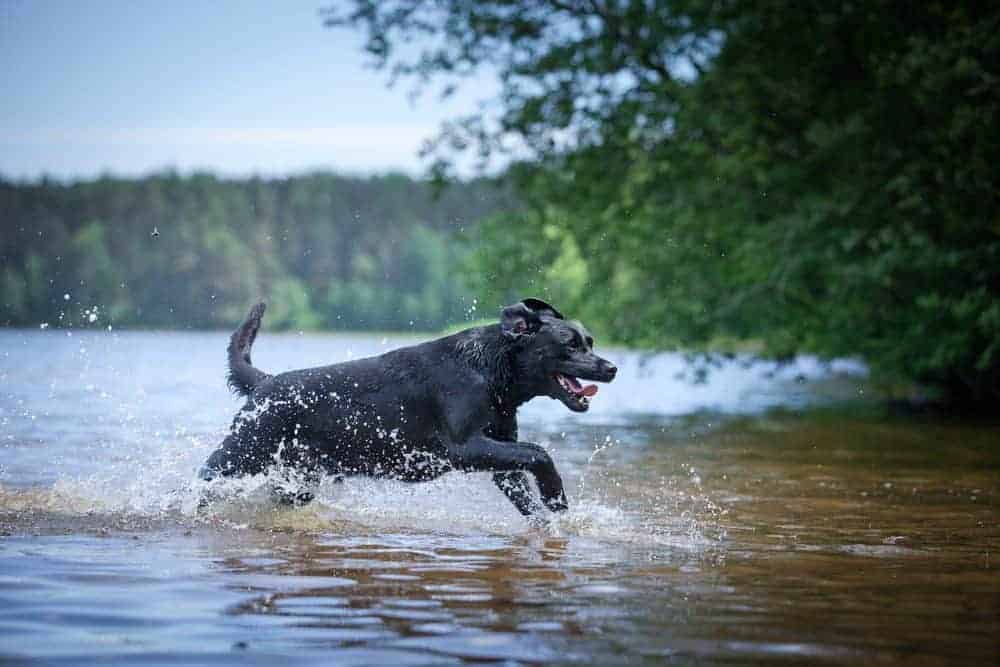
Letting your dog have a paddle on a hot day to cool down may seem like the most natural activity – but it could be fraught with danger. With an increase in reports of toxic blue green algae in several locations across the UK this summer, the British Veterinary Association (BVA) is urging pet owners to take extra precautions while walking their dogs in the vicinity of affected water bodies.
BVA Junior Vice President Daniella Dos Santos said: “We know that some dogs enjoy nothing better than a paddle in a cool lake while on a walk during summer months, but my advice to pet owners would be to keep your dog on a lead during walks near water confirmed to have toxic algal blooms. While not all blue green algae are poisonous, it is impossible to tell the difference visually, so it is better to be safe than sorry.”
What is blue green algae?
Blue green algae blooms may appear as green or greenish-brown scum on the surface of water and are caused by cyanobacteria. When the bacteria decay, they release toxins, a turquoise pigment (hence the name) and a potent odour akin to rotting vegetables.
These toxins can be harmful for animals if ingested, even in small quantities. Dogs can swallow the algae by drinking water from an affected lake, river or pond or while licking their fur after going for a swim.
Where has it been found?
This summer, the presence of blue green algae has been confirmed in water bodies in Southampton and Fleet in Hampshire, Edinburgh and Elgin in Scotland, Cornwall, Leicestershire, Derbyshire, and Lincolnshire, among other locations. According to reports, at least four dogs have died in the UK after venturing into to waterways known or thought to have be home to the algae.
Is it becoming more common?
Commenting in The Guardian, Professor Laurence Carvalho, of the UK’s Centre of Ecology and Hydrology, explained that the incidence of blooms is increasing owing to two key factors: nutrients and heat: “The fundamentally important thing is plant nutrients – nitrogen and phosphorus. It’s the pollution of our lakes and reservoirs with treated sewage effluent and agricultural runoff. Most sewage treatment removes organic chemicals and harmful bacteria, but they don’t remove nutrients, so when that effluent enters our waters, they are much more enriched than in natural conditions.”
His team have found that the conditions for the blue-green algae’s growth are further enhanced when the water temperature is above 17degC. Professor Carvalho added: “There’s pretty strong evidence that climate change is leading to increased problems, more widespread and intense blooms, right across the globe. We expect with warming that things will get worse.”
What are the symptoms?
Symptoms of exposure can appear within a few minutes or hours, depending on the type of toxin ingested, and commonly include vomiting, diarrhoea, drooling, disorientation, trouble breathing, seizures and blood in faeces. If left untreated, it can cause liver damage and ultimately be rapidly fatal.
Daniella Dos Santos advises: “There is currently no known antidote for the toxins, so prompt veterinary treatment is essential to tackle their effects and ensure a good chance of recovery. If you suspect your dog has been exposed to blue green algae, rush it to your local vet without delay."
Top tips from the BVA to keep your pets safe
- Look out for any warning signs put up by the Environment Agency or local councils near water bodies
- Keep pets on a lead and by your side around water bodies known or suspected to have blue-green algal bloom – don’t let them swim in it or drink from it
- If your dog has been swimming outside, wash them thoroughly with clean water afterwards
- Rush your pet to a vet immediately in case you’re concerned they may have ingested toxic algae
If you found this interesting, you may also like:
Wet and wild
Dogs and water mean fun times for our four-legged pals on a blazing summer’s day – as long as you choose the right swimming locations and avoid potential hazard hot-spots
Deadly dog disease casts a long shadow across the UK
Vets are issuing a stark warning to dog owners to be extra vigilant. Lungworm – a potentially fatal canine disease – is now occurring in previously ‘safe’ areas of the country
Countryside call backs
The lure of the great outdoors with its enticing sights, sounds and smells can be just too distracting for some dogs. If you struggle with getting your canine chum to come when you call them, try our top dos and don’ts of recall
Having a barbecue? Make sure your pets stay safe
Firing up the barbecue and inviting friends and family round for some al fresco dining is one of the best things about summer. However, if you have pets, there are several safety issues to consider...
Sources: bva.co.uk, theguardian.com














